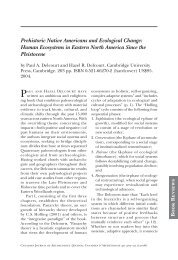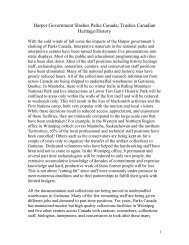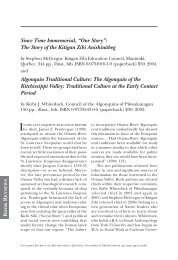investigate their formation and relative chronology. Preliminary results of stratigraphicand micromorphological analyses <strong>de</strong>monstrate that episo<strong>de</strong>s of hearth use wereinterrupted by periods of disuse and possible site abandonment, and that it laterfunctioned as a pit for domestic waste. These analyses also support a cultural origin forthe hill-like feature and indicate that it prece<strong>de</strong>s the formation of the hearth. Theseinvestigations suggest a broa<strong>de</strong>r history of cultural activity at Fort Denison that inclu<strong>de</strong>sthe periods preceding and post-dating military occupation of the site.Gilliland, Krista (Western Heritage, St Albert), W. Paul Ad<strong>de</strong>rley (University ofStirling), Terrance Gibson (Western Heritage, St Albert), Dave Norris (WesternHeritage, Winnipeg) Context, Chronology, and Culture: Problem-basedGeoarchaeology at the Lakehead Complex Sites, Thun<strong>de</strong>r Bay (19) With the goal ofadvancing site interpretations to inclu<strong>de</strong> the broa<strong>de</strong>r landscape and cultural contexts,geoarchaeological work at the Lakehead Complex/Interlake Complex sites in the Thun<strong>de</strong>rBay region is addressing three fundamental problems. Firstly, we comment on the natureand extent of disturbance and re<strong>de</strong>position at these sites. Secondly, we investigate theorigin of pit-like <strong>de</strong>pressions that are frequently associated with more <strong>de</strong>eply buriedartifact-bearing sediments. Thirdly, we address the relative lack of a <strong>de</strong>tailed chronologyfor these sites. Using a combination of stratigraphic and thin section analyses,luminescence profiling, and optical dating, we document the <strong>de</strong>positional history ofpredominantly artifact-bearing sediments to construct key stratigraphic and chronologicalframeworks for the site complex. Our work has broa<strong>de</strong>r resonance with current issuesregarding interpreting archaeological sites in fluvial landscapes, establishing chronologiesat sites with poor organic preservation, and employing sediment-based evi<strong>de</strong>nce to furtherun<strong>de</strong>rstandings of sites found in Boreal forest settings.Gillot, Céline (Doctorante, Département d'Anthropologie, Université <strong>de</strong> Montréal)The role of thin section petrography in the un<strong>de</strong>rstanding of ancient architecturalpractices: A case study from the Maya site of Río Bec (Mexico)(21) Despite the significantachievements ma<strong>de</strong> over the last few <strong>de</strong>ca<strong>de</strong>s in the scientific examination ofarchaeological materials and the constant <strong>de</strong>velopment of new efficient analyticaltechniques, conventional thin section petrography continues to hold an important place inthe archaeologist's toolkit. Simple observation of thin sections with a polarizingmicroscope still has the potential to provi<strong>de</strong> large amount of information not easilyobtained by other methods. In some cases, this basic method can even be sufficient toanswer the archaeologists' questions. Using as an example the work carried out on thebuilding materials employed in the prehispanic Maya site of Río Bec, this presentationaims to <strong>de</strong>monstrate how valuable petrographic analyses are for the un<strong>de</strong>rstanding of pastarchitectures in particular. They may bring new insights not only on the building materialsand the construction techniques, but also on the technological choices ma<strong>de</strong> by thebuil<strong>de</strong>rs and the reasons behind these choices.Girard-Rheault, Marilyn, (Université <strong>de</strong> Montréal) Les camélidés et l’archéologiepéruvienne (1) Les camélidés furent les mammifères les plus polyvalents pour l’hommeen Amérique du sud avant l’arrivée <strong>de</strong>s colons. Les archéologues attestent non seulement<strong>de</strong> leur présence durant toute la préhistoire, mais aussi <strong>de</strong> leur exploitation par les peuples
préhispaniques. Parmi ces camélidés, il semble qu’un petit camélidé, aujourd’hui disparu,ait été exploité par les Mochicas. Afin <strong>de</strong> mieux comprendre l’évolution <strong>de</strong>s camélidés et<strong>de</strong> leur relation avec les peuples préhispaniques, il serait nécessaire d’effectuer davantaged’analyses génétiques (ADN) sur les restes fauniques attribués aux camélidés. Cesnouvelles sources d’informations offriraient un nouveau regard sur les donnéesarchéologiques et ethnohistoriques.Griggs, Carol (Cornell Tree Ring Laboratory, Cornell University, Ithaca, NY)Climate change during the mid-Younger Dryas to early Holocene evi<strong>de</strong>nt in buried logsfound southeast of Lake Ontario (13) Horizontal logs sticking out of the bank of BellCreek near Fulton, NY, intrigued the landowner enough to contact the Cornell Tree RingLaboratory. Five samples were collected on the first visit, and 14C dates of two samplesplaced one in early and the other in mid-Holocene. Subsequent collection and analysis ofsamples from 75 logs exten<strong>de</strong>d the range back into the mid-Younger Dryas with asignificant <strong>number</strong> of samples from the middle YD into the Preboreal chronozone duringthe early Holocene. Tree-ring chronologies and stable isotope analysis indicate severalclumps of extreme environmental and climatic change at the site. The site’s location onthe southeastern lowlands of Lake Ontario and the lake sediments below the logs indicatethat the changes potentially link to those on a much larger scale (e.g. isostatic rebound,meltwater drainage from the northwest, and changes in the level of ancestral LakeOntario) during the retreat of the Laurenti<strong>de</strong> ice sheet.Guiry, Eric J. 1 , Vaughan Grimes 1,2 , and Domingo C. Salazar-García 21 Memorial University, 2 Department of Human Evolution, Max Plank Institute forEvolutionary Anthropology, Leipzig, Germany. Dogs as Dietary Proxies for Humans inBone Chemistry: Case Studies from the Maritime Archaic and Spanish Copper Age (31)Domestic dog (Canis familiaris) remains have been recognized as possible proxies forhumans in stable isotope-based paleodietary reconstructions. In light of the NativeAmerican Graves Protection and Repatriation Act and similar legislation, this ‘CanineSurrogacy Approach’ (CSA) has been used as a method for reducing reliance on directanalyses of human remains. The majority of CSA applications have been conducted on anad hoc basis and few systematic analyses of the <strong>de</strong>gree to which dog stable isotopesignatures cross-contextually reflect those of humans have been conducted. This postercompares human and dog stable carbon and nitrogen isotope data <strong>de</strong>riving from MaritimeArchaic as well as a Spanish Copper Age sites in or<strong>de</strong>r to assess the suitability of dogremains as proxies for associated humans in pre-contact/prehistoric hunter-gatherer andagricultural contexts. Results suggest that dogs in these contexts can provi<strong>de</strong> suitable,albeit rough, proxies for their human keepers.Guiry 1 , Eric J. , Stéphane Noël 2 , Céline Dupont-Hébert 2 , and Vaughan Grimes 1,3Un<strong>de</strong>rstanding Meat Provisioning Practices among Historic North Atlantic Fisheries:Insights from Stable Isotope Analyses (14) 1 Department of Archaeology, MemorialUniversity, St. John’s, NL Canada, A1C 5S7. 2 Laboratoires d’archéologie, Départmentd’histoire, Université Laval, Québec City, QC, Canada, G1V 0A6. 3 Department of HumanEvolution, Max Plank Institute for Evolutionary Anthropology, Leipzig, Germany, 04103.Newfoundland and Iceland were annually visited and/or settled in part by European cod
- Page 1 and 2: RÉSUMÉS / ABSTRACTSPar ordre alph
- Page 3 and 4: glyphs in images for posterity have
- Page 5 and 6: Balac, Anne-Marie (Ministère de la
- Page 8: Bergeron, André (Centre de conserv
- Page 12 and 13: forme traditionnelle imprimée ou d
- Page 14: after learning about what happened
- Page 17 and 18: Cadieux, Nicolas, Jean-Christophe O
- Page 19: known in the area, both historic an
- Page 22 and 23: Comeau, Jennifer (Memorial Universi
- Page 24 and 25: in single households. Given that th
- Page 27 and 28: Crompton, Amanda (Memorial Universi
- Page 29 and 30: describe the spatial extent of the
- Page 31 and 32: Columbia. Although dogs are not a d
- Page 33 and 34: planification des fouilles archéol
- Page 35 and 36: synthèse des données biophysiques
- Page 37 and 38: Ellis, Christopher (University of W
- Page 39 and 40: ever made in an archaeological site
- Page 41 and 42: qui occupait déjà l’esprit des
- Page 43: impliqués dans les pêcheries et l
- Page 47 and 48: archaeometrists these days is a tec
- Page 49 and 50: patches undertaken to identify the
- Page 51 and 52: integration of feature, artifact an
- Page 53 and 54: l’appellation crie désignant les
- Page 55 and 56: order to ensure there was no damage
- Page 57 and 58: in 1851 as a market and destroyed i
- Page 59 and 60: devait tenir compte des grands prin
- Page 61 and 62: elusive has been a consistent way o
- Page 63 and 64: driving forces in Québec archaeolo
- Page 65 and 66: Ly, Yvonne (Archéotec inc.) Essai
- Page 67 and 68: contribution de Google Earth à la
- Page 69 and 70: to its taphonomic agent. These obse
- Page 71 and 72: Monchot, Hervé (Université Paris
- Page 73 and 74: horticulturalists. Broad-bladed bif
- Page 75 and 76: Oetelaar, Gerald (University of Cal
- Page 77 and 78: Paxton-MacRae, Mark (Western Herita
- Page 79 and 80: 19 th and 20 th centuries. Old-grow
- Page 81 and 82: while deer, particularly white tail
- Page 83 and 84: Rankin, Lisa K. (Memorial Universit
- Page 85 and 86: Robinson IV, Francis (University at
- Page 87 and 88: Royer, Martin (Ethnoscop inc.) Inve
- Page 89 and 90: Sifontes, Sarah (York University) D
- Page 91 and 92: isotopique par spectrométrie de ma
- Page 93 and 94: quarries have been discovered and e
- Page 95 and 96:
aux XVII e et XVIII e siècles (25)
- Page 97 and 98:
last rapids of St. Laurence river.
- Page 99 and 100:
Woods, Audrey (Université de Montr
- Page 101 and 102:
theorizing material culture, much o








